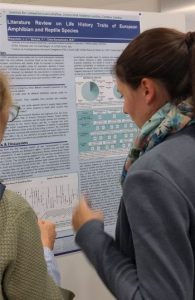Student blogger Lara and Prof. Ralf Schäfer report from the EFSA’s Conference “Environmental risk assessment of pesticides: 25 years of scientific advancements since the adoption of Directive 91/414/EEC”.
In November 2016, the European Food Safety Authority (EFSA) organized a conference in Parma on the past, present and future state of environmental risk assessment (ERA) within the EU to celebrate the 25th anniversary of the Directive 91/414/EEC and discuss future developments.
Participants from different backgrounds were invited to present and exchange their point of views, opinions and experiences with ERA during the two days of conference. Beside 16 invited talks from experts from government, NGOs, academia, consultants and industry, as well as a penal and plenary discussion, the conference featured poster sessions, where current research topics in the field of ERA were presented.
The University of Koblenz-Landau was represented by Ralf B. Schäfer, head of the Quantitative Landscape Ecology group at the Institute for Environmental Science, and Lara Petschick, a M.Sc. Ecotoxicology student. Ralf Schäfer was invited to present the academic view on current Environmental Risk Assessment and Lara Petschick presented a poster with the results of her internship at EFSA.

During the coffee breaks, there was time to have a look at the posters and to chat with the authors (photo by K. Ferrini)
The first day of the conference dealt largely with the history of the last 25 years of ERA and with views on the current state of ERA, which were presented by representatives of government, NGOs, industry, consulting and academia. We got the impression that most stakeholders directly involved in pesticide authorisation (industry, government) are reasonably content with what has been achieved. The strongest criticism was expressed by representatives of environmental NGOs, citing several papers from members of the Institute of Environmental Sciences. Interestingly, the group of consultants, which were surveyed regarding current ERA, were divided regarding ERA’s complexity, protectiveness and restrictedness. This divide was also apparent in the wrap up session of that day, which lead to paradoxical summary that current ERA is: “too complex, too restrictive, but at the same time insufficiently protective”. Consequently, this ignited interesting discussions during the evenings “Networking Cocktail”, which continued in a following pub crawl. The discussions were especially exciting due to the different backgrounds of participants joining the event: the priorities between environmental protection and secure food production as well as between corporate and public interests can be balanced very differently.
The second day of the conference dealt with the future of ERA. Most participants agreed that the future ERA should be more spatially explicit and that spatial and ecological modelling will play a major role in future developments. However, it was repeatedly emphasised that this will require huge research efforts, joint model development by different stakeholders and an accompanying field monitoring to validate the models. Thus, some participants were sceptical whether this vision will ever see the light of the day. In addition, we got the impression that most participants consented that the future ERA should be less complex. Overall, the conference provided us with an interesting overview of the different view points of the stakeholders and a potential roadmap to future ERA.
